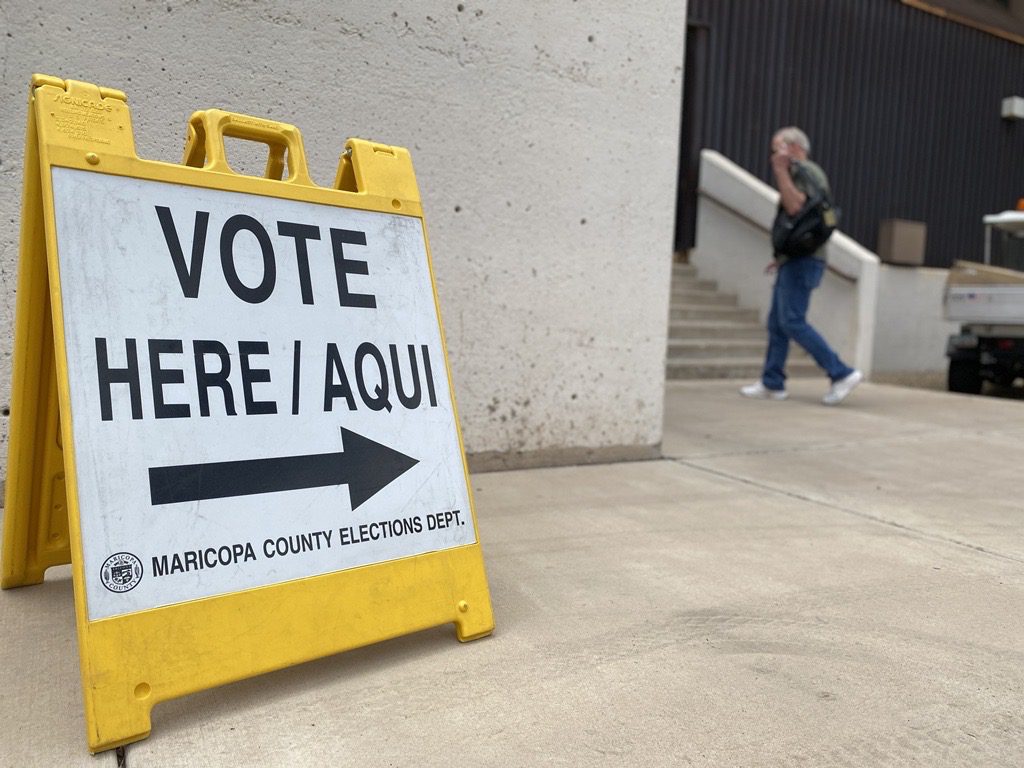“An Attempt to Fool Voters”: Ohio GOP Sets Up Vote To Weaken Direct Democracy
Republicans rushed an Aug. 8 election to change the rules for constitutional amendment referendums in advance of a potential fall vote on abortion.
| June 1, 2023

Republicans have attained a near-lock on governance in Ohio. But as they rush to stop a popular drive to protect abortion access in the state, they’re moving to limit voters’ best remaining option to challenge their unfettered power.
Ohio Republicans passed a measure in May that creates an Aug. 8 election to end Ohioans’ right to directly amend their state constitution with a simple majority vote.
Voters will decide on that day whether to adopt a proposal that would increase the threshold to change Ohio’s constitution from 50 to 60 percent, and that would make it harder for residents to get constitutional amendments on the ballot in the first place. If it passes, the measure would dramatically curtail a tool of direct democracy that has existed in the state for more than a century.
“It’s an attempt to fool voters into giving away their power,” said Mia Lewis of Common Cause Ohio, a pro-democracy group that opposes the amendment.
Ohio Republicans’ latest effort follows a recent pattern. In numerous states where they have near-total dominance and the only option to challenge them is through statewide referendums or constitutional amendments, Republicans have moved to attack direct democracy itself.
Arkansas Republicans recently passed a law that makes it harder to qualify ballot measures for a popular vote, as did Utah in 2021. Arizona Republicans attempted to do the same last fall, to mixed results. Republican legislators in Florida, Idaho, Missouri, North Dakota and Oklahoma have made similar attempts this year, to varying degrees of success. In the maneuver most reminiscent of Ohio’s, South Dakota Republicans rushed through a summer referendum last year in an attempt to make it harder for a Medicaid expansion plan to pass later that year. Voters rejected their last-minute gambit, then passed Medicaid expansion over their objections last fall.
Now, Republicans are trying the same playbook in Ohio.
The precipitating reason for this amendment is a push to enshrine abortion as a constitutional right. After the U.S. Supreme Court’s 2022 decision that ended the federally-guaranteed right to an abortion, Ohio Republicans passed legislation to ban most abortion in the state, though that law is currently pending legal review. Abortion rights groups responded with a campaign to amend the constitution, attempting to follow in the footsteps of similar initiatives that passed in California, Michigan, and Vermont last fall, and in March they got the greenlight to start collecting signatures for a November referendum.
Anti-abortion groups lobbied GOP lawmakers to support a constitutional amendment to make it harder for any future amendments to pass, and rush to get it in place before voters can weigh in on abortion.
“Their true motivation, aside from their insatiable desire for power, is to stop women from having the reproductive freedom that we so deserve,” Representative Jessica Miranda, Ohio House Democrats’ Minority Whip, told Bolts.
Republicans sought to paint this proposed amendment as a necessary adjustment to protect Ohioans against deep-pocketed out-of-state special interests rather than one focused on blocking abortion rights.
“By voting yes on August 8, Ohioans will be protecting our constitution from special interests for generations to come, while still preserving the people’s important role in governing our state,” Ohio GOP Chairman Alex Triantafilou said in a recent statement.
“We believe the Ohio constitution is a foundational document and shouldn’t be home to every whimsical issue that comes down the road,” said Rob Nichols, a spokesperson for Republican Secretary of State Frank LaRose.
But Republicans have occasionally admitted what this push is really about.
“There is a reason that every far left group in Ohio is fighting so hard to preserve their ability to do an end run around us,” state Representative Brian Stewart, the Republican who spearheaded the effort to create the referendum, wrote his GOP colleagues in a December letter obtained by the Cleveland Plain Dealer. “After decades of work to make Ohio a pro-life state, the Left intends to write abortion on demand into Ohio’s Constitution. If they succeed, all the work accomplished by multiple Republican majorities will be undone, and we will return to 19,000+ babies being aborted each year.”
In holding this vote, Ohio Republicans are doing an about-face from a position they held just a few months ago. In December, the GOP-controlled legislature passed a law to eliminate August elections because of the difficulty and additional expense for holding them, as well as the historically low voter turnout during a time of year when many people are on vacation.
LaRose said at the time that August elections “aren’t good for the taxpayer, elections officials, voters or the civic health of our state,” and lamented their historically low turnout.
But after the GOP failed to move the proposal through the legislature in time to put it on the ballot for the spring primary, LaRose and other Republicans changed their tune.
His spokesperson punted when asked why his boss had reversed his position.
“The general assembly has the authority to establish the time, place and manner for an election. It’s their call, and they chose to do an August election,” Nichols told Bolts. “It’s not our call.”
He also shrugged off concerns from local election workers about the cost and effort of an August election, saying he had faith that local officials were up to the task.
“They’re professionals, they’ve been through this before,” he said. “There have been August elections routinely in the past, and they’ve handled themselves flawlessly.”
The amendment’s opponents have filed a lawsuit in an attempt to block the vote from happening at all, arguing it violates this recently passed law banning most August elections.
In a separate lawsuit, they are seeking a court order to alter the Republican-drafted language for the amendment, which their lawyers described in a court brief as a “misleading, prejudicial ballot title and inaccurate.”
Surveys suggest Republicans are out of step with the voters in the GOP-leaning state—both on abortion and on their wish to curtail direct democracy.
An October poll by Baldwin Wallace University found that 59 percent of Ohioans supported a constitutional amendment to make abortion access a fundamental right—enough support to pass with a simple majority, but just shy of a 60-percent threshold—with just 27 percent opposing it.
But it doesn’t seem like the GOP’s attempted end-around is any more popular with voters than their attempts to curtail abortion access.
An early May poll conducted by the group leading the efforts against the amendment to change constitutional referendums found that Ohio voters would oppose the measure by a margin of 52 to 21 percent. Strategists in both parties say that other private polling indicates the measure is currently opposed by majorities of Ohioans.
“The overwhelming response to this from people has been outrage,” Democratic Ohio state House Minority Leader Allison Russo told Bolts. “They see this as a power grab from a gerrymandered, unaccountable legislature that wants to take away power from people and put it more firmly into politicians’ hands.”
The proposed amendment has drawn a broad swath of opposition. Traditional Democratic allies like Planned Parenthood, the Sierra Club, the AFL-CIO and numerous left-leaning labor groups have been joined by the Fraternal Order of Police and the Libertarian Party. The bipartisan Ohio Association of Elections Officials came out in official opposition to it because of the added work and unnecessary cost to taxpayers, which is expected to run as high as $20 million.
The referendum has also drawn opposition from two former GOP state attorneys general, as well as all four of Ohio’s living former governors—including Republicans John Kasich and Bob Taft.
Even some Republicans don’t seem that keen on the August vote. The bill only passed the Ohio legislature after months of foot-dragging from reluctant GOP leaders and heavy pressure from anti-abortion rights groups, in spite of a GOP supermajority in both chambers. Republican Governor Mike DeWine only came out in support after it had already been passed by the legislature after months of debate. And the Ohio Business Roundtable, a conservative-leaning coalition of business groups that usually works closely with Republicans, has decided to stay on the sidelines.
But the new law’s sponsors and their allies in the religious right and business community are now rallying to the cause.
The Ohio Republican Party recently launched an effort aimed at turning out GOP base voters, and a coalition of pro-GOP business organizations headed by the Ohio Chamber of Commerce recently launched an operation to provide air support. Those groups largely back the amendment because they want to make it easier to defeat a 2024 constitutional amendment to raise the state’s minimum wage.
Given the GOP’s insistence that this is about keeping outside special interests from changing the state constitution, it’s ironic that the biggest individual donor so far to back the amendment is an Illinois billionaire. Dick Uihlein, a GOP megadonor and shipping supplies magnate who has a particular fondness for election deniers and social conservative causes, is the biggest donor behind Save Our Constitution, a super PAC that spent more than $1 million on ads badgering reluctant Republican state lawmakers into passing legislation to create the August vote.
The proposal doesn’t just increase the threshold needed for voters to pass constitutional amendments—it also makes it much harder for groups to get amendments in front of the voters. Currently, organizations and movements need to secure signatures from five percent of registered voters in 44 of the state’s 88 counties to get a constitutional amendment on the ballot. The new rule, if approved, would force groups to get enough signatures in every single county—and eliminate the 10-day cure period that currently exists for groups to fix any errors in signatures to qualify for the ballot.
If passed, the Aug. 8 measure would only apply to future constitutional amendments; it would not change the process that governs the initiatives that change regular statutes. Voters would still be able initiate laws or repeal ones passed by the legislature with a simple majority of the statewide vote.
But state legislators can immediately re-pass the same or similar laws or repeal voter-backed legislation, giving them an effective veto over popular opinion.
The election is scheduled for the second Tuesday in August, where the proposed amendment will be the only question on the ballot. According to early reports, local election officials are scrambling to secure enough poll workers and polling locations in time.
August elections are typically very low-turnout affairs, with between 5 and 10 percent of registered voters actually casting ballots. Both sides are gearing up to spend heavily on the race, and expect slightly higher turnout due to the gravity of the issue.
But the amendment’s opponents seem much more confident than its advocates.
“It’s gonna be a tough fight in August, and it’s really going to be about getting out the vote,” said Russo, the House minority leader. “But I feel confident that it will be defeated.”
Sign up and stay up-to-date
Our weekly newsletter on the local politics of criminal justice and voting rights




